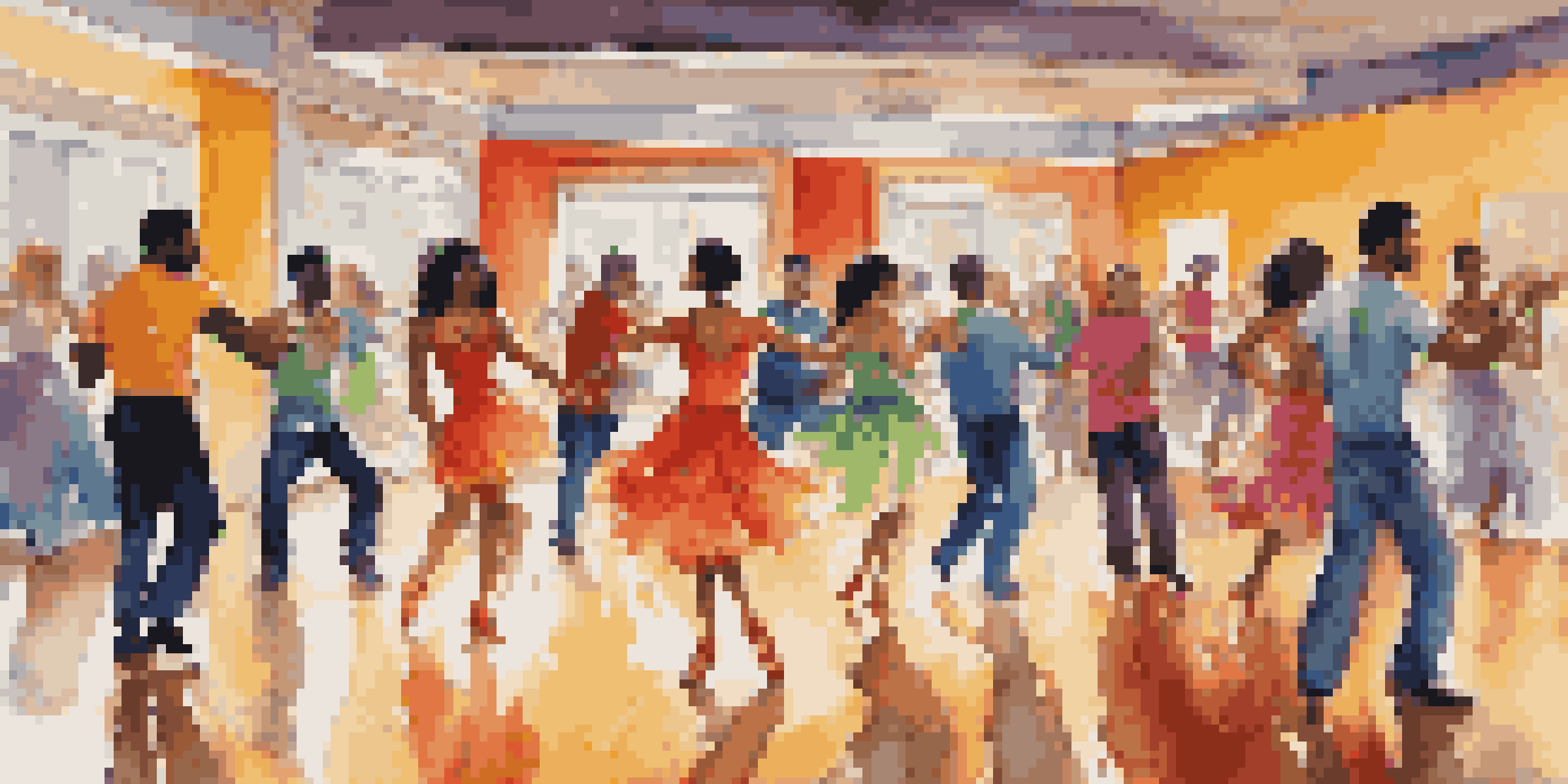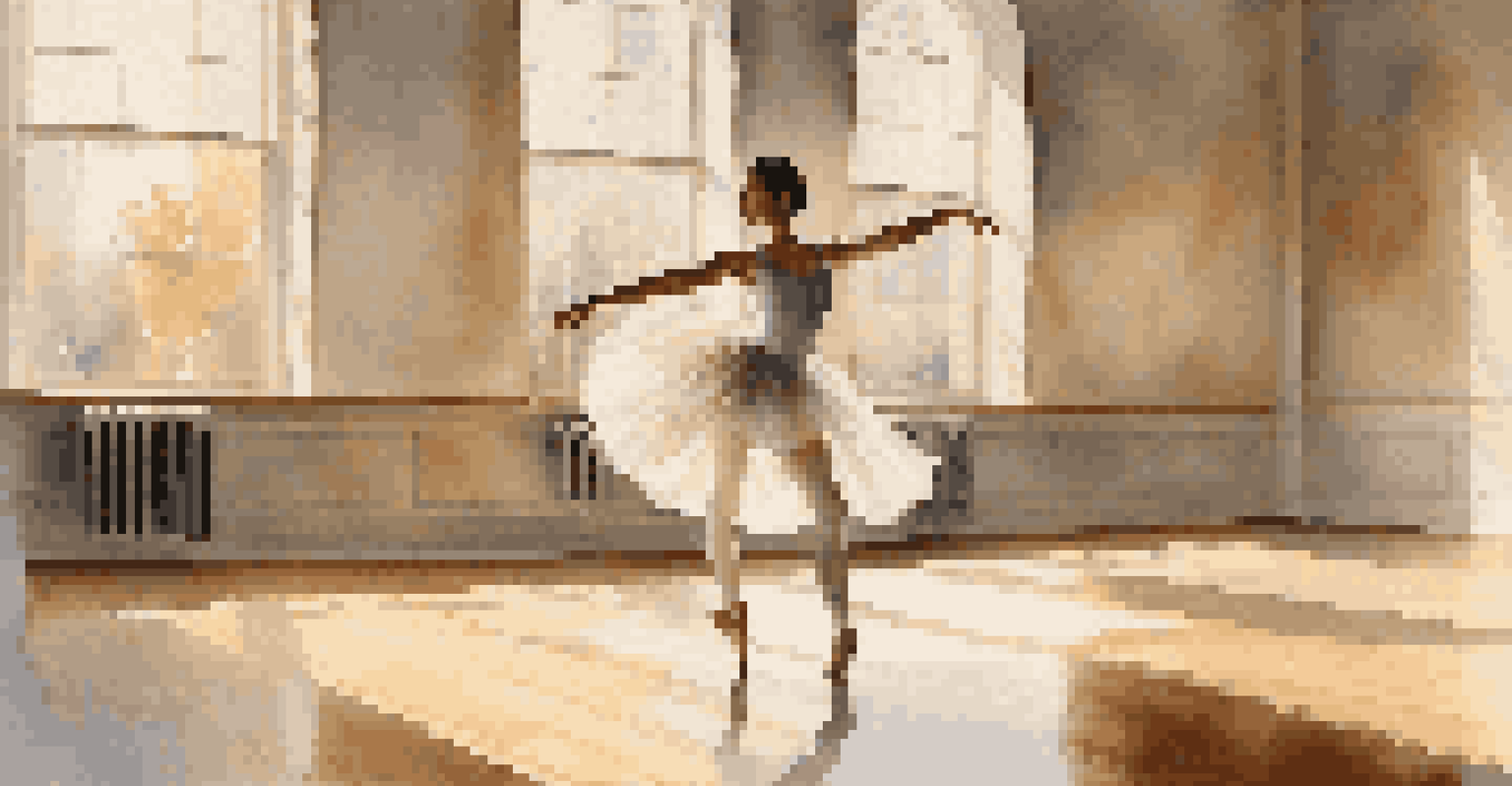Exploring Dance Genres: Their Unique Mental Health Benefits

The Joy of Dance: A Universal Language for Healing
Dance transcends cultural barriers, providing a joyful outlet for expression. When we dance, we tap into a universal language that connects us to our emotions and to others. This sense of connection can alleviate feelings of loneliness or isolation, promoting a healthier mental state.
Dance is the hidden language of the soul.
Moreover, engaging in dance releases endorphins, often referred to as 'feel-good' hormones. This hormonal boost can lead to an immediate uplift in mood, making dance an effective tool for combating anxiety and depression. The rhythm and movement can act as a natural remedy, bringing a sense of euphoria.
For many, dancing also serves as a form of mindfulness. When we focus on the movement and the music, we often find ourselves in a state of flow, where worries fade away. This present-moment awareness is crucial for mental well-being and can lead to better stress management.
Ballet: Grace and Discipline for Mental Resilience
Ballet is not just a beautiful art form; it also instills a sense of discipline and focus. Practicing ballet requires dedication, which can foster a sense of accomplishment and improve self-esteem. This structured approach can be particularly beneficial for those seeking stability in their mental health.

The rigorous training involved in ballet also encourages physical fitness, which is linked to improved mental health. As dancers master complex movements, they develop patience and perseverance. These qualities translate into everyday life, helping individuals cope with challenges more effectively.
Dance as a Healing Outlet
Engaging in dance promotes emotional expression and connection, which can alleviate feelings of loneliness and enhance mental well-being.
Furthermore, the expressive nature of ballet allows dancers to convey deep emotions through movement. This emotional release can be therapeutic, enabling dancers to process feelings they might struggle to articulate verbally. In this way, ballet becomes a powerful tool for emotional healing.
Hip-Hop: A Dynamic Outlet for Self-Expression
Hip-hop dance is all about self-expression, creativity, and freedom. This genre encourages individuals to showcase their personality through unique movements, which can be incredibly liberating. As dancers express themselves, they often experience a boost in confidence and self-worth.
The body says what words cannot.
The energetic nature of hip-hop also promotes physical activity, which is known to combat stress and anxiety. Engaging in high-energy dance sessions can be a fun and effective way to channel pent-up energy or frustration. This form of dance often feels like a celebration, making mental health benefits feel like a natural byproduct.
Additionally, hip-hop communities foster a sense of belonging. Through dance battles and collaborations, dancers connect with like-minded individuals, creating supportive networks. This sense of community can be crucial for mental well-being, as it reduces feelings of isolation.
Contemporary Dance: Navigating Emotions through Movement
Contemporary dance is often characterized by its fluidity and ability to convey complex emotions. This genre allows dancers to interpret their feelings and experiences through movement, creating a unique form of emotional release. Engaging in contemporary dance can help individuals process emotions that might be challenging to express in words.
The improvisational aspect of contemporary dance encourages spontaneity and creativity, which can be incredibly liberating. This freedom allows dancers to explore their inner selves, fostering self-discovery and personal growth. Such exploration can lead to a deeper understanding of one’s mental health and emotional landscape.
Ballet Builds Discipline and Resilience
The structured training of ballet fosters self-discipline and emotional expression, helping individuals improve their mental health.
Moreover, the focus on body awareness in contemporary dance promotes mindfulness. As dancers become attuned to their bodies and movements, they cultivate a greater connection between mind and body. This holistic approach can enhance overall well-being and reduce stress.
Salsa: The Social Benefits of Dance
Salsa dance is as much about social interaction as it is about the movements. The vibrant, rhythmic nature of salsa encourages participants to connect, which can be incredibly beneficial for mental health. Engaging with others through dance fosters relationships and creates a supportive environment.
The physical activity involved in salsa promotes endorphin release, boosting mood and reducing stress. As dancers move to the infectious rhythms, they experience joy and exhilaration, making salsa a delightful way to unwind and have fun. This playful aspect of salsa can serve as a much-needed escape from daily stresses.
Additionally, salsa classes often provide a sense of community. Meeting new people and forming connections through shared interests can enhance feelings of belonging and support mental well-being. This social component is key to building resilience against loneliness.
Jazz: The Rhythm of Life and Self-Expression
Jazz dance is known for its energetic and expressive movements, allowing dancers to showcase their personality. This genre invites individuals to interpret the music in their unique style, which can significantly boost self-esteem and confidence. The freedom to express oneself through rhythm is empowering and enriching.
The physical demands of jazz dance also contribute to improved mental health. As dancers engage in vigorous routines, they not only enhance their fitness but also reap the mental health benefits associated with physical activity. This connection between body and mind is essential for overall well-being.
Community Through Hip-Hop Dance
Hip-hop dance encourages self-expression and creates supportive communities, reducing feelings of isolation and boosting mental health.
Moreover, the improvisational elements of jazz dance encourage creativity and spontaneity. This focus on expression allows individuals to explore their emotions without judgment, fostering a sense of liberation. Such experiences can lead to greater emotional awareness and resilience.
Dance Therapy: A Structured Path to Mental Wellness
Dance therapy is a specialized form of therapy that uses movement to support emotional, cognitive, and social integration. It combines traditional therapeutic practices with the expressive nature of dance, providing a unique outlet for healing. This approach can be particularly beneficial for those dealing with trauma or emotional difficulties.
In dance therapy, individuals learn to express their feelings through movement, which can often be more accessible than verbal communication. This method encourages self-discovery and emotional processing, making it a powerful tool for mental health. Participants often report a renewed sense of hope and purpose following their experiences.

Additionally, dance therapy fosters a supportive environment where individuals can connect with others facing similar challenges. This sense of community can be incredibly validating, helping participants feel less alone in their struggles. Ultimately, dance therapy offers a structured yet creative pathway to improved mental wellness.